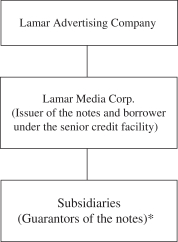LAMAR ADVERTISING COMPANY
AND SUBSIDIARIES
Notes to Consolidated Financial Statements
(Dollars in thousands, except share and per share data)
(18) Distribution Restrictions
Lamar Media’s ability to make distributions to Lamar Advertising is restricted under both the terms of the indentures relating to Lamar Media’s outstanding notes and by the terms of its senior credit facility. As of December 31, 2018 and December 31, 2017, Lamar Media was permitted under the terms of its outstanding senior subordinated and senior notes to make transfers to Lamar Advertising in the form of cash dividends, loans or advances in amounts up to $3,156,061 and $2,975,593, respectively.
As of December 31, 2018, Lamar Media’s senior credit facility allows it to make transfers to Lamar Advertising in any taxable year up to the amount of Lamar Advertising’s taxable income (without any deduction for dividends paid). In addition, as of December 31, 2018, transfers to Lamar Advertising are permitted under Lamar Media’s senior credit facility and as defined therein up to the available cumulative credit, as long as no default has occurred and is continuing and, after giving effect to such distributions, (i) the total debt ratio is less than 6.5 to 1 and (ii) the secured debt ratio does not exceed 3.5 to 1. As of December 31, 2018, the total debt ratio was less than 6.5 to 1 and Lamar Media’s secured debt ratio was less than 3.5 to 1, and the available cumulative credit was $1,906,541.
(19) Fair Value of Financial Instruments
At December 31, 2018 and 2017, the Company’s financial instruments included cash and cash equivalents, marketable securities, accounts receivable, investments, accounts payable and borrowings. The fair values of cash and cash equivalents, accounts receivable, accounts payable and short-term borrowings and current portion of long-term debt approximated carrying values because of the short-term nature of these instruments. Investments and initial recognition of asset retirement obligations are reported at fair values. Fair values for investments held at cost are not readily available, but are estimated to approximate fair value. The estimated fair value of the Company’s long term debt (including current maturities) was $2,904,851, which is less than both the gross and carrying amount of $2,914,552 as of December 31, 2018. The majority of the fair value is determined using observed prices of publicly traded debt (level 1 in the fair value hierarchy) and the remaining is valued based on quoted prices for similar debt (level 2 in the fair value hierarchy).
(20) Information about Geographic Areas
Revenues from external customers attributable to foreign countries totaled $35,146, $33,424 and $32,669 for the years ended December 31, 2018, 2017 and 2016, respectively. Net carrying value of long lived assets located in foreign countries totaled $2,387 and $3,571 as of December 31, 2018 and 2017, respectively. All other revenues from external customers and long lived assets relate to domestic operations.
(21) New Accounting Pronouncements
Revenue
In May 2014, the FASB issued Accounting Standards Update (“ASU”)No. 2014-09 (Codified as ASC 606), Revenue from Contracts with Customers, which requires an entity to recognize the amount of revenue to which it expects to be entitled for the transfer of promised goods or services to customers. The ASU replaced most existing revenue recognition guidance in U.S. GAAP when it became effective. In August 2015, the FASB issued ASUNo. 2015-14 deferring the effective date from January 1, 2017 to January 1, 2018, while allowing for early adoption as of January 1, 2017. The standard permits the use of either the retrospective or cumulative effect transition method. The Company adopted the provisions of ASC 606 on January 1, 2018 using the cumulative
F-35

